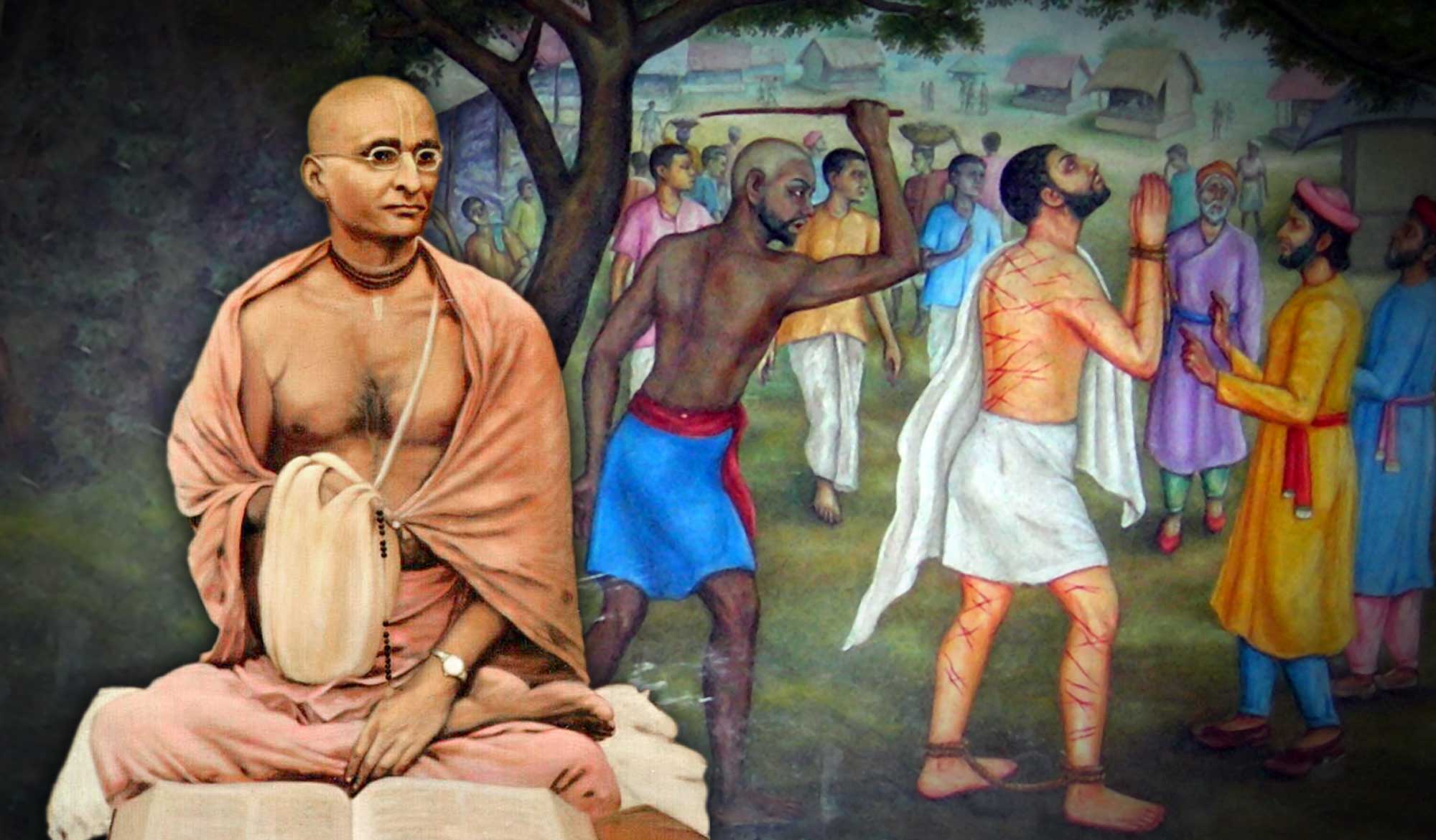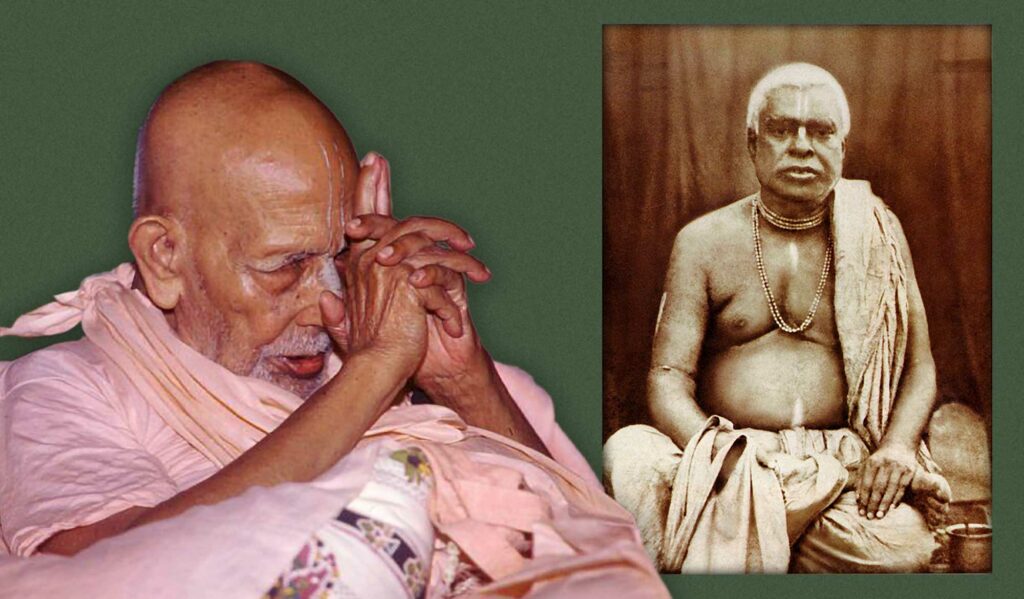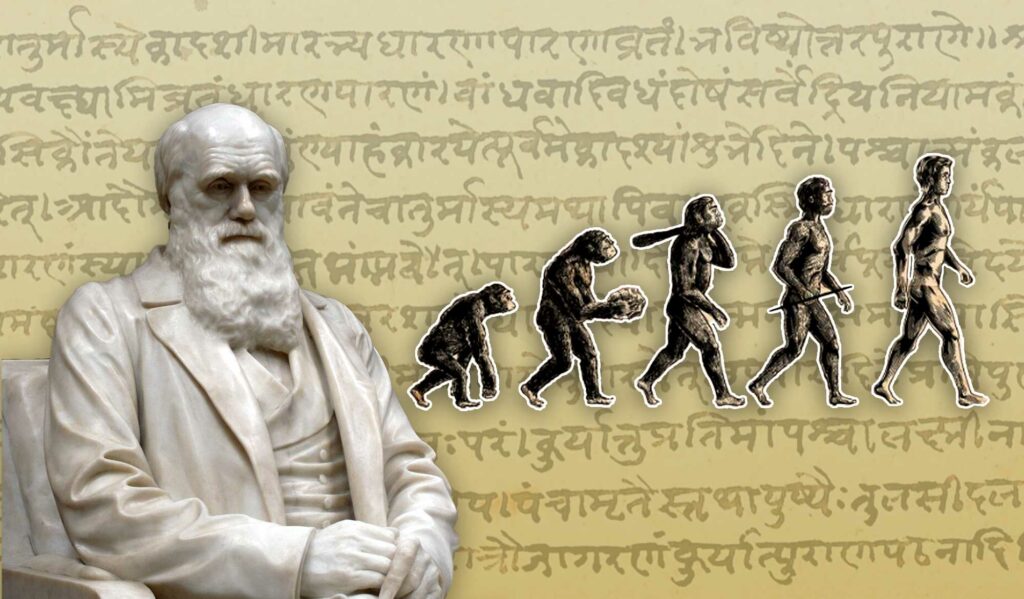Overview
Sajjana – Akṛta-droha (A Devotee Does Not Engage in Violence) was written by Śrīla Bhaktisiddhānta Sarasvatī Ṭhākura Prabhupāda and published in Sajjana Toṣaṇī, Vol. 20, Issue 3 in 1917. Continuing from his previous article (Sajjana – Kṛpālu), Sarasvatī Ṭhākura explains how a true Vaiṣṇava is never violent to others in thought, word or deed.
(Translated from the original Bengali by Sanātana Dāsa and Parameśvarī Devī Dāsī.)
Previously, we had described the concept of mercy (kṛpālu) in a sajjana (A Devotee is Merciful – Sajjana Kṛpālu). If one secretly nurtures irrelevant motivations within one’s heart and comes to be known by the people of this world as a Vaiṣṇava, then such behaviour will never indicate that he is merciful. Even one who is actually averse to Hari and, in order to deceive people, is externally known by the designation ‘Vaiṣṇava’ should not possess the tendency known as envy internally. He who is an actual Vaiṣṇava, by his own svabhāva (inherent nature) has no tendency towards violence internally or externally. A vaiṣṇava-sajjana is merciful. Just as mercy is the embellishment of man, in the same way, violence is ugliness. A Vaiṣṇava is kind to others, but he is not defiant under the sway of violence. If violence is seen in a Vaiṣṇava, then he cannot be called merciful. If a covered truth is revealed for the benefit of others, it should be known as mercy. However, if lies is propagated by a malicious mind under the guise of truth, then that ‘mercy’ develops into violence.
Akṛta-droha (non-violence) is the second of the twenty-six qualities of a Vaiṣṇava. In this world, only a Vaiṣṇava is non-violent. He is not violent with others. Two types of violence are seen. Endeavouring to directly show violence to others with one’s mind, body and words – this is one type of violence. The other kind of violence is not to prevent a jīva who is the perpetrator of injustice, from planning to behave cruelly with another jīva. A Vaiṣṇava asks a jīva to become free from the coverings of anyābhilāṣa (other material desires), karma and jñāna, and to engage in hari-sevā. From this, his non-violent characteristic comes to be known. A Vaiṣṇava is thought of by ignorant jīvas who lack any vision of their future reactions, to be a hater of anyābhilāṣīs, karmīs and jñānīs, but since he is kind he becomes impelled by mercy and desires auspiciousness for the jīva and does not envy them. A Vaiṣṇava who becomes saddened for the jīvas and instructs them in service to Hari, is non-violent. One who is envious of others being propelled by the modes of passion and ignorance is known by all to be a violent non-devotee. These two types of violence never find a place within the inherent nature of a Vaiṣṇava.
Non-violence alone is the supreme dharma. We are aware of the various forms of cruelty to jīvas – the greed for animal flesh, the desire to taste the blood and skin of fish, the craving to eat eggs and those things still in the womb. In the guise of dharma, various kinds of wicked arguments appear in order to support the violent tendencies in some people. Violence towards weak animals and tormenting weak human beings is prohibited by the edicts of the nīti-śāstra (those scriptures dealing with ethics). In order to prevent unethical activities, different types of rules, regulations and secular dharma-śāstras have been propagated within civilised human society. Forgetting his real self, the jīva crosses these ethics due to his selfish mentality, causing inconvenience to other members of society. There is no chance of mitigating violent tendencies by artificial means. Only if the jīva becomes engaged in service to Hari can he can be freed from violence.
The violence of a non-Vaiṣṇava is a sin. If a wicked person commits sin he must experience anxiety. Hence engaging in violence is not a worthwhile activity for a non-Vaiṣṇava. A Vaiṣṇava cannot be violent with anyone. As a barren woman is unable to give birth to a son, as milk cannot be obtained from water, similarly it is impossible for a Vaiṣṇava to be violent. For the welfare of the society, the dharma-śāstra and scholars of ethics have decided that if one is benefited one should respond with favour, and if one faces violence one should respond with violence. There is no fault in this. But the broadminded Vaiṣṇava says, “If a non-devotee commits violence to a Vaiṣṇava, the Vaiṣṇava will tolerate it silently.
At the time when a digvijayī-paṇḍita, intoxicated with his scholarly prowess, collected a jaya-patra (a certificate of victory) from Śrī Rūpa and Śrī Sanātana, thereby committing violence against vaiṣṇava–dharma, then due to the exemplary characters of the two Gosvāmīs, they signed the jaya-patra with cheerful faces. This is the non-violence of a Vaiṣṇava. Furthermore, when Śrī Jīva Gosvāmī showed his extraordinary tendency for non-violence by being merciful to the talented paṇḍita who was envious of Vaiṣṇavas and had committed violence towards his gurus, then Śrī Jīva’s compassionate heart did not become sullied by the defect of violence.
At the time when a rich brāḥmaṉa named Rāmacandra Khāṅ was in the process of committing violence against Śrī Hari Dāsa Ṭhākura and tried to cause trouble by sending a prostitute, then the great soul Hari Dāsa Ṭhākura did not take revenge on Rāmacandra Khaṅ. This is the non-violence of a Vaiṣṇava. There is no violence of any kind in Bhagavān’s compassion towards Jagāi and Mādhāī, in the mercy of Hari Dāsa Ṭhākura to the prostitute, and Gaurahari’s grace on Sārvabhauma. Vāsudeva who personally accepted punishment for the sins of the entire earth, and Christ who showed mercy to those who were inimical even when they showed violence by putting him on the cross etc. are indications of the non-violent mentality of the representatives of Hari.
This is why Śrī Gaurasundara has said, taror api sahiṣṇunā (‘One should be more tolerant than a tree.’).
taru-sama sahiṣṇutā vaiṣṇava karibe
bhartsana-tāḍane kāke kichu nā balibe
kāṭileha taru yena kichu nā bolaya
śukāiyā mare, tabu jala nā māgaya
(A Vaiṣṇava should be as tolerant as a tree. Even if anyone insults him or beats him, he will not say anything to anyone. Even when he is cut, the tree says nothing. If he is drying up and dying, he does not ask for water. – Caitanya–caritāmṛta, Ādi–līlā 17.27-28)
yei ye māgaye, tāre deya āpana-dhana
gharma-vṛṣṭi sahe, ānera karaye rakṣaṇa
(If anyone asks anything from him, he gives his own wealth. He tolerates the heat and the rain, and still protects others. – Caitanya–caritāmṛta, Antya–līlā 120.24)
(Translated from Bengal by Swami B.V. Giri)
Related Articles & Books
- Vaiṣṇava Nindā by Śrīla Bhaktivinoda Ṭhākura
- A Devotee is Merciful (Sajjana – Kṛpālu) by Śrīla Bhaktisiddhānta Sarasvatī Ṭhākura
- A Devotee Does Not Engage in Violence (Sajjana – Akṛta-droha) by Śrīla Bhaktisiddhānta Sarasvatī Ṭhākura
- A Devotee is the Epitome of Truth (Sajjana – Satya-sāra) by Śrīla Bhaktisiddhānta Sarasvatī Thākura
- Śiva-tattva & the Position of Lord Śiva by Śrīla B.R. Śrīdhara Mahārāja
- Oh Bābā! Bolacche-re! by Śrīla B.R. Śrīdhara Mahārāja
- Problems and Solutions by Śrīla B.R. Śrīdhara Mahārāja
- The Highest Attainment and Present Adjustment by Śrīla B.R. Śrīdhara Mahārāja
- Āgun Jvālbe (Light the Fire!) by Śrīla B.R. Śrīdhara Mahārāja
- Dharma and the Modern World by Śrīla A.C. Bhaktivedānta Swami Prabhupāda
- Faith Confirms the Absolute by Śrīla B.G. Narasiṅgha Mahārāja
- Go Deeper! by Śrīla B.G. Narasiṅgha Mahārāja
- To Be a Servant by Śrīla B.G. Narasiṅgha Mahārāja
- Harmony – Real and Apparent by Swami B.V. Giri
- The Definition of Faith by Gaura Gopāla Dāsa
- Ātma Samīkṣā – The Value of Introspection by Kalki Dāsa
- Frogs in the Well of Prejudice by Kalki Dāsa
Further Reading
- Śraddhā (Faith) – Quotes by Bhaktivinoda Thakura
- Śraddhā and Śaraṇāgati by Śrīla Bhaktivinoda Ṭhākura
- The Association of Sādhus by Śrīla Bhaktivinoda Ṭhākura
- Epilogue to Śrī Kṛṣṇa Karṇāmṛta by Śrīla Bhaktivinoda Ṭhākura
- Prīti (Love) by Śrīla Bhaktivinoda Ṭhākura
- A Dispute Concerning Mahāprasāda by Śrīla Bhaktivinoda Ṭhākura
- Śraddhā by Śrīla Bhaktivinoda Ṭhākura
- Materialistic Association by Śrīla Bhaktivinoda Ṭhākura
- Dispelling Doubts by Śrīla Bhaktivinoda Ṭhākura
- The Enemy by Śrīla Bhaktivinoda Ṭhākura
- A Critique of the book ‘Vanamālā’ by Śrīla Bhaktivinoda Ṭhākura
- Kali by Śrīla Bhaktivinoda Ṭhākura
- Offences Against Bhakti by Śrīla Bhaktivinoda Ṭhākura
- Kārttika-vrata by Śrīla Bhaktivinoda Ṭhākura
- Violence and Mercy by Śrīla Bhaktivinoda Ṭhākura
- Abandoning Bad Association by Śrīla Bhaktivinoda Ṭhākura
- Sad-guṇa and Bhakti by Śrīla Bhaktivinoda Ṭhākura
- The Process of Initiation by Śrīla Bhaktivinoda Ṭhākura
- Dainya (Humility) by Śrīla Bhaktivinoda Ṭhākura
- Vaiṣṇava Nindā (Offences to Devotees) by Śrīla Bhaktivinoda Ṭhākura
Pilgrimage with Swami Narasiṅgha – Part 7: Keśī Ghāṭa
Continuing with our pilgrimage series, this week Śrīla Narasiṅgha Mahārāja takes us to Keśī Ghāṭā where he tells us about Madhumaṅgala’s meeting with the Keśī demon, what Keśī represents, and how Śrīla Prabhupāda almost acquired Keśī Ghāṭa. Mahārāja also narrates his own experience. This article has been adapted from a number of talks and articles by Narasiṅgha Mahārāja.
Prema Dhāma Deva Stotram with the Narasiṅgha Sevaka Commentary – Verses 61-65
In verses 61 to 65 of 'Prema Dhāma Deva Stotram', Śrīla Śrīdhara Mahārāja narrates the pastime of Śrī Caitanya at Caṭaka Parvata In Purī and explains how the scriptures produced by Brahmā and Śiva are ultimately searching for the personality of Mahāprabhu who is merciful too all jīvas, no matter what their social position.
Prabhupāda Śrīla Sarasvatī Ṭhākura’s Visit to Ayodhyā
With the forthcoming observance of Śrī Rāma Navamī, we present 'Prabhupāda Śrīla Sarasvatī Ṭhākura’s Visit to Ayodhyā' written by Śrīla Bhaktisiddhānta Sarasvatī Ṭhākura Prabhupāda from The Gaudīyā magazine, Vol 3. Issue 21/ In December 1924, after visiting Benares and Prāyāga, Sarasvatī Ṭhākura visited the birth-site of Śrī Rāmācandra in Ayodhyā.
Śaraṇāgati – The Only Path to Auspiciousness
In this article, 'Śaraṇāgati - The Only Path to Auspiciousness', Dhīra Lalitā Dāsī analyses the process of śaraṇāgati (surrender) beginning with śraddhā (faith). She also discusses the role of śāstra and the Vaiṣṇava in connection with surrender.
Pilgrimage with Swami Narasiṅgha – Part 7: Keśī Ghāṭa
Continuing with our pilgrimage series, this week Śrīla Narasiṅgha Mahārāja takes us to Keśī Ghāṭā where he tells us about Madhumaṅgala’s meeting with the Keśī demon, what Keśī represents, and how Śrīla Prabhupāda almost acquired Keśī Ghāṭa. Mahārāja also narrates his own experience. This article has been adapted from a number of talks and articles by Narasiṅgha Mahārāja.
Prema Dhāma Deva Stotram with the Narasiṅgha Sevaka Commentary – Verses 61-65
In verses 61 to 65 of 'Prema Dhāma Deva Stotram', Śrīla Śrīdhara Mahārāja narrates the pastime of Śrī Caitanya at Caṭaka Parvata In Purī and explains how the scriptures produced by Brahmā and Śiva are ultimately searching for the personality of Mahāprabhu who is merciful too all jīvas, no matter what their social position.
Prabhupāda Śrīla Sarasvatī Ṭhākura’s Visit to Ayodhyā
With the forthcoming observance of Śrī Rāma Navamī, we present 'Prabhupāda Śrīla Sarasvatī Ṭhākura’s Visit to Ayodhyā' written by Śrīla Bhaktisiddhānta Sarasvatī Ṭhākura Prabhupāda from The Gaudīyā magazine, Vol 3. Issue 21/ In December 1924, after visiting Benares and Prāyāga, Sarasvatī Ṭhākura visited the birth-site of Śrī Rāmācandra in Ayodhyā.
Śaraṇāgati – The Only Path to Auspiciousness
In this article, 'Śaraṇāgati - The Only Path to Auspiciousness', Dhīra Lalitā Dāsī analyses the process of śaraṇāgati (surrender) beginning with śraddhā (faith). She also discusses the role of śāstra and the Vaiṣṇava in connection with surrender.








